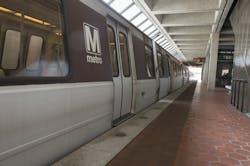Wayside Energy Storage: Taking Regenerative Braking Savings to the Next Level
For many transit agencies, saving energy equals saving money. As the second busiest rapid transit system in the U.S., the Washington Metropolitan Area Transit Authority’s (Metro) Metrorail knows this to be true. Metrorail includes six lines with more than 117-route miles of track and 91 passenger stations. The trains are powered by more than 100 traction-power substations through a third rail 700v DC distribution system, consuming approximately 500,000 megawatt hours per year at a cost of $48 million.
A large percentage of passenger trains, including all of those in use on the Metrorail system, are capable of using regenerative braking to reduce energy consumption and overall traction power costs. However, overall energy savings are dependent upon trains demanding power being near trains generating power. This method has proven to provide some cost savings, but a significant amount of the regenerated energy is still lost as heat, leaving a huge potential to achieve even greater energy savings.
To reach its goal of reducing energy use by 15 percent by 2025, Metro looked at ways it could store the unused energy from regenerative braking and use it when needed. The Metro team considered both wayside and onboard storage options and determined that for the current system, a wayside energy storage substation would provide the most benefits.
Metro collaborated with Gannett Fleming Transit & Rail Systems (GFT&RS), and the Federal Transit Administration (FTA) to test this solution through a demonstration project. After an extensive assessment of different wayside energy storage technologies, including flywheels, electrochemical capacitators and batteries, Metro selected the battery power system (BPS).
Using proven battery technology, a 2 megawatt BPS was installed in West Falls Church Yard on the Orange Line of the Metrorail network. The system uses a high-capacity Gigacell Nickel-metal Hydride technology and was developed specifically for rail and transit applications. This setup offers high scalability in both the number and capacity of cells, rapid charge and discharge capabilities, and cycle durability. The batteries have a low operating temperature and feature water-based electrolytes, which eliminates the risk of fire, providing simplicity and safety. Additionally, because the batteries do not use lead, mercury, cadmium or other toxic materials, they are environmentally friendly and are easy to disassemble for recycling.
Electronic data recorders also were installed to collect the performance data, including rectifier currents, DC bus voltage, and BPS charge and discharge currents. The project team accessed the recorded data remotely and download it regularly for analysis. They conducted a number of test scenarios to evaluate the performance of the BPS. The system was tested with 6 megawatt rectifiers, 3 megawatt rectifiers, and without any rectifiers, acting as a tie-breaker station. In each of the three situations, energy savings, peak power savings and system voltage improvement were calculated. The analyses indicated that all these objectives were achieved through the demonstration project.
Furthermore, Metro also gauged the ability to use the BPS for emergency power. To demonstrate the interaction between the BPS and trains under controlled conditions, two tests that used the BPS as the sole source of power for train movements were conducted. A section of track was powered by the BPS alone and a 6-car train without passengers started from a standstill and moved 2,800 feet at a speed of 10 miles per hour. This train movement consumed 4 percent of the BPS energy capacity. Calculations showed that if the train had been loaded with 175 passengers per car, the same train movement would have consumed 5.24 percent of the BPS energy capacity, indicating that the fully charged BPS can support 19 such train movements in succession if the BPS is not used to supply any other load.
This feature provides an important safety benefit to Metro and its passengers. With the system’s many tunnels, during a possible blackout situation, the BPS would allow Metro to move the passengers from the tunnel to the nearest station for evacuation. This also is a critical consideration for transit agencies in earthquake zones.
Following the successful completion of the demonstration project, Gannett Fleming is continuing to work with Metro to assess the feasibility of optimizing regenerative braking energy recovery across the entire system by deploying the wayside energy systems, inverters and reversible thyristor controlled rectifiers at suitable locations.
The FTA partially sponsored this project so that the experience gained from this demonstration can be shared with the wider industry. The results of the Metro wayside energy storage project can help other transit agencies understand the benefits and applicability of wayside energy storage systems for their own transit organizations.
The project also is an example of how emerging technology can be adapted to meet the needs of transit agencies. As many transit organizations face the challenges of increased energy costs and providing service to growing riderships, they will continue to look to new and existing technologies to meet these needs. Finding the right partner to develop adaptive strategies will be key in advancing these projects.
Full demonstration project details can be found in the FTA final report at: fta.dot.gov/documents/FTA_Report_No._0086.pdf.
J. Gordon Yu, PhD, CEng, Manager of Traction Power Analysis for Gannett Fleming Transit & Rail Systems.
